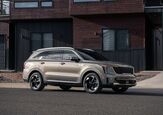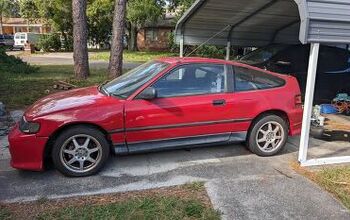Report: People Willing to Pay Stupid Prices for New Cars

While we’d like to get away from stories about everything becoming more expensive, everything actually is becoming more expensive and it looks like a healthy slice of the population is allegedly willing to go along with it. According to the latest data coming from Cox Automotive, roughly 40 percent of the U.S. population would purchase a vehicle at 12 percent above sticker. There’s always been a subset of shoppers who don’t know when they’re being taken but this represents a healthy share of the country.
It makes one wonder where these surveys were being conducted until Cox summarized the situation as the direct result of a populace beaten down by their environment. Apparently, people no longer expect to find good deals and have not yet reached the point where they’ll feel comfortable driving around in the same busted crate that’s seen them through the last decade as a way to save money.
“The global shortage of microchips is one of the top stories right now in the automobile business, and if you are a consumer looking for a new vehicle, you don’t have to search hard to see the reports,” notes Vanessa Ton, senior industry intelligence manager at Kelley Blue Book (KBB), a Cox Automotive company. “Shoppers are expecting high prices and limited choices, and that’s exactly what they are finding.”
In dollars, that 12-percent increase amounts to roughly $4,900 — as the price of the average new car now exceeded $40,000 at the start of this year. And almost half the population is willing to pay it, according to the survey. But KBB suggested the prices are probably a bit higher than that, citing its own elevated pricing metrics over the last couple of months:
The Kelley Blue Book research shows that 87 [percent] of consumers recognize the issue is impacting both domestic and import nameplates. As the issue is industry-wide, 73 [percent] of consumers are expecting to face higher prices at the dealerships, and nearly 60 [percent] believe they will find lower incentives. Four out of ten consumers are willing to pay above the manufacturer’s suggested retail price (MSRP), and those willing to pay over MSRP are willing to accept a 12 [percent] premium. In April, according to Kelley Blue Book estimates, the average MSRP for a new vehicle in the U.S. was $41,950. In other words, many consumers are willing to pay $5,000 over sticker price.
Awareness of what has become a “seller’s market” has steered some consumers to the sidelines. The research shows that 37 [percent] of in-market consumers are now planning to postpone their purchase. Of those consumers deciding to delay, 70 [percent] will step back for three months or more. Only 23 [percent] of new-vehicle intenders are willing to switch their purchase intention to a used vehicle. Fewer are willing to shift segments.
That’s a shame because yours truly was hoping to see an influx of economy-focused compacts that eventually made way for high-strung and performance-focused siblings. Instead, it looks like we’ll just have people blowing over 40 grand on crossover vehicles.
Though the 37 percent of people that Cox claims are getting out of the market (at least temporarily) could make the assumed price tolerances short-lived. Some people (likely yourself) are simply unwilling to live with the shame associated with paying way over sticker and, if supply issues are solved and production schedules normalize, the industry could find itself with a totally new set of problems. Though we don’t foresee anything like that happening until the end of 2021, if not substantially later.
[Image: Gretchen Gunda Enger/Shutterstock]

A staunch consumer advocate tracking industry trends and regulation. Before joining TTAC, Matt spent a decade working for marketing and research firms based in NYC. Clients included several of the world’s largest automakers, global tire brands, and aftermarket part suppliers. Dissatisfied with the corporate world and resentful of having to wear suits everyday, he pivoted to writing about cars. Since then, that man has become an ardent supporter of the right-to-repair movement, been interviewed on the auto industry by national radio broadcasts, driven more rental cars than anyone ever should, participated in amateur rallying events, and received the requisite minimum training as sanctioned by the SCCA. Handy with a wrench, Matt grew up surrounded by Detroit auto workers and managed to get a pizza delivery job before he was legally eligible. He later found himself driving box trucks through Manhattan, guaranteeing future sympathy for actual truckers. He continues to conduct research pertaining to the automotive sector as an independent contractor and has since moved back to his native Michigan, closer to where the cars are born. A contrarian, Matt claims to prefer understeer — stating that front and all-wheel drive vehicles cater best to his driving style.
More by Matt Posky
Latest Car Reviews
Read moreLatest Product Reviews
Read moreRecent Comments
- Teddyc73 Doesn't matter, out of control Democrats will still do everything they can to force us to drive them.
- Teddyc73 Look at that dreary lifeless color scheme. The dull grey and black wheels and trim is infecting the auto world like a disease. Americans are living in grey houses with grey interiors driving look a like boring grey cars with black interiors and working in grey buildings with grey interiors. America is turning into a living black and white movie.
- Jalop1991 take longer than expected.Uh-huh. Gotcha. Next step: acknowledging that the fantasies of 2020 were indeed fantasies, and "longer than expected" is 2024 code word for "not gonna happen at all".But we can't actually say that, right? It's like COVID. You remember that, don't you? That thing that was going to kill the entire planet unless you all were good little boys and girls and strapped yourself into your living room and never left, just like the government told you to do. That thing you're now completely ignoring, and will now deny publicly that you ever agreed with the government about.Take your "EV-only as of 2025" cards from 2020 and put them in the same file with your COVID shot cards.
- Jalop1991 Every state. - Alex Roy
- CanadaCraig My 2006 300C SRT8 weighs 4,100 lbs. The all-new 2024 Dodge Charge EV weighs 5,800 lbs. Would it not be fair to assume that in an accident the vehicles these new Chargers hit will suffer more damage? And perhaps kill more people?


































Comments
Join the conversation
Buy: None Drive: None Burn: All
We bought a 2014 Ford Flex new. that now, has 60k miles on it. Paid MSRP for 60 month/0% Financing. Payments ended 2 years ago. I expect 8-9 years more before replacement at this rate. Brakes, Tires (replaced the crappy Hankooks that wore out early) Battery twice. Phoenix is hell on Batteries. I should be shopping again around 2028, at this rate.